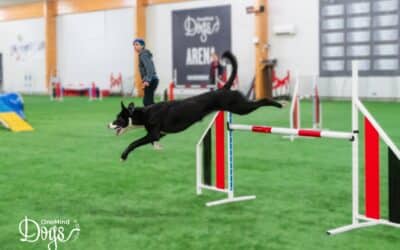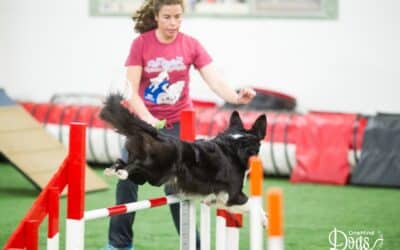Have you heard of an agility handling technique called the “Reverse Spin”? Would you like to know exactly what it is, why it’s used and how to apply it? If so, then read on below! Even if you’ve never heard of the Reverse Spin before, we encourage you to read on and learn more about this powerful technique!
Welcome to OneMind Dogs! We are a passionate company dedicated to helping people understand their dog’s perspective. Our mission is brought to life by a dynamic team of dog trainers and agility coaches. We focus on enhancing the communication between dogs and their handlers through innovative methods developed by our founders.
The OneMind Dogs method is made up of many parts. These come together to create a big picture of connection and exceptional partnership with your dog. Our popular agility handling techniques are one part of this picture and the Reverse Spin is the technique we’ll discuss today. Let’s dive right in!
What is a reverse spin in dog agility?
The Reverse Spin is a handling technique designed to change your dog’s direction after an obstacle. It is also very useful to avoid trap obstacles (aka “trapstacles”) that might appear on your dog’s natural line.
For example, if the dog sees a tunnel behind a jump that he is not meant to take, you can use a Reverse Spin once the dog commits to the jump. This will tell your dog that you want him to divert his line away from the tunnel once he lands from the jump. Cueing the turn early is key as it gives your dog time to alter their take-off and jump effort as required to turn safely and comfortably. See some video examples here.
Using the Reverse Spin in agility
Reverse Spin requires you to turn into your dog once they commit to the obstacle where you want them to turn. The best thing about this technique? You can handle a turn no matter where you are on the course. That’s right — even if you are behind the dog or at a distance laterally, your dog will instinctively understand to turn when you use a Reverse Spin. This is a versatile technique that dogs naturally understand!
You can control the tightness of the turn created with a Reverse Spin using two important handling elements:
- The timing of your head turn
- The direction of your movement after the turn
Learn more in our free webinar: Reliable Reverse Spins
Reverse spin vs. Front Cross
To clarify things further, let’s compare the Reverse spin with another popular agility handling technique called the Front Cross. These techniques may seem similar as they both start the same way. What makes them different is the side your dog is on after the turn.
In the Front Cross, the handler switches sides during the turn, resulting in the dog completing a turn and being on a new handling side for the next part of the course. However, in a Reverse Spin, the dog turns but remains on the same handling side after the turn. This is achieved by the handler rotating inwards and turning their back on the dog and then turning their head to look over their shoulder and reconnect with the dog on the original handling side as seen in the video below.
7 Handling Elements that cue a flawless reverse spin
Executing a Reverse Spin does not require any prior intricate agility handling knowledge or verbals for the dog. As long as your dog has a reasonable level of obstacle focus, it’s simple to learn. If your dog is very handler focused, you will likely not need a Reverse Spin in your handling toolbox yet. As with all of the OneMind Dogs handling techniques, we break the Reverse Spin down into 7 handling elements. Let’s discuss these in a bit more detail.
Movement
When performing a Reverse Spin on an obstacle, move towards the obstacle until the dog is committed to it. At that point, you can use a rhythm change to help the dog collect their stride if the turn is tight or the dog is highly obstacle focused. For more handler focused dogs, you can help the dog with the commitment by stepping towards the take-off point using the foot that’s nearer to the dog. Remember, you don’t need to be close to the obstacle. Once your dog commits to it, you can start the Reverse Spin.
The direction of your movement after the Reverse Spin has a strong impact on your dog’s line after the obstacle. Make sure you are moving around 1m / 3 feet away from your dog’s intended line. Ensure your movement is parallel to the line your dog should take to the next obstacle.
Position
The handler’s position is a bit off the obstacle. Ideally, you want to be positioned closer to the next obstacle as you start the turn, so you are able to stay ahead of the dog and to use your position to help the dog know where they are going next on the course.
Eyes
You should maintain connection with your dog as they approach the obstacle, so that you can see the commitment. Once you start the turn, you should re-connect over your shoulder as you move off to the next obstacle. If you need a tighter turn, you can delay your head-turn as shown in the video below.
Chest
Turn your chest towards the take-off point until the dog has committed to the obstacle, dogs follow the direction of our chest so this will help to support the dog’s commitment to the obstacle more easily. After the dog has committed, turn your chest towards the direction of the next obstacle.
Feet
On approach to the obstacle, take a step with your foot that’s closest to the dog towards the take-off point of the obstacle. This helps with the dog’s commitment and also helps you to step through the turn. Take the weight off your other foot and use it to step backwards in the direction of the next obstacle. Then as your body turns, all other steps should be forward, parallel to the line you want your dog to take to the next obstacle.
Hands
Your guiding arm (the arm closest to your dog) supports your dog’s motion towards the take-off point of the obstacle, at least until commitment. As there is no change of handling side with the Reverse Spin, the guiding arm should stay the same after the handler has done a spin and the dog has landed.
Voice
Depending on your dog’s level of obstacle / handler focus, you can use a verbal cue to help the dog commit to taking the jump (for example “jump”), or you can use a verbal cue to help the dog collect for the turn (for example a “shhh” sound) if needed. Try the turn with no verbal first and that should give you some information as to what your dog needs.
We encourage you to focus on all seven elements of this technique during practice sessions, practice on your own first until you can do them all without thinking about it too much, then bring in your dog. Remember to stay patient and consistent – mastery comes over time with repeated practice.
Conclusion
The Reverse Spin has a unique capacity to easily change your dog’s direction on the agility course. It’s also great for avoiding trapstacles at the same time, without the need for any learned cues for the dog. It is indeed a resourceful tool in your handling strategy. Successful execution of the Reverse Spin involves a combination of accurate footwork, body positioning, and connection. Practice and patience will make this tool an invaluable addition to your toolbox.
If you need help with your training, please don’t hesitate to get in touch and send us a video!



